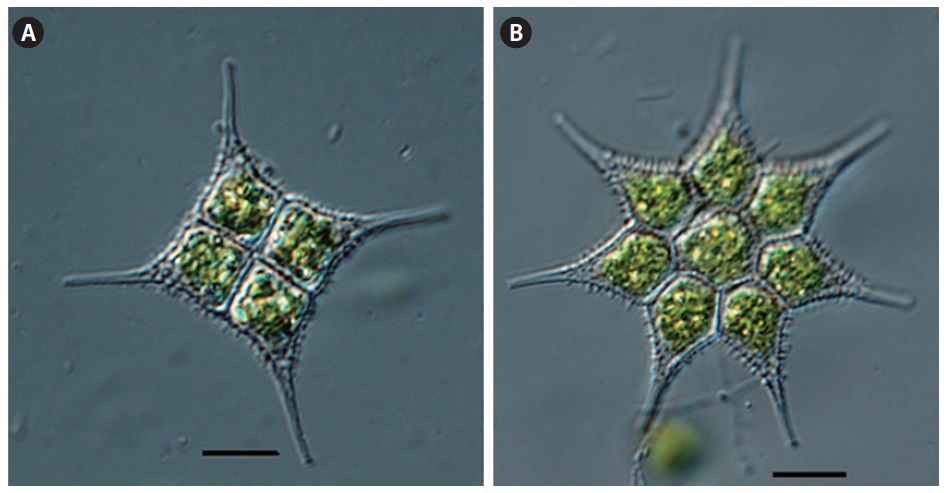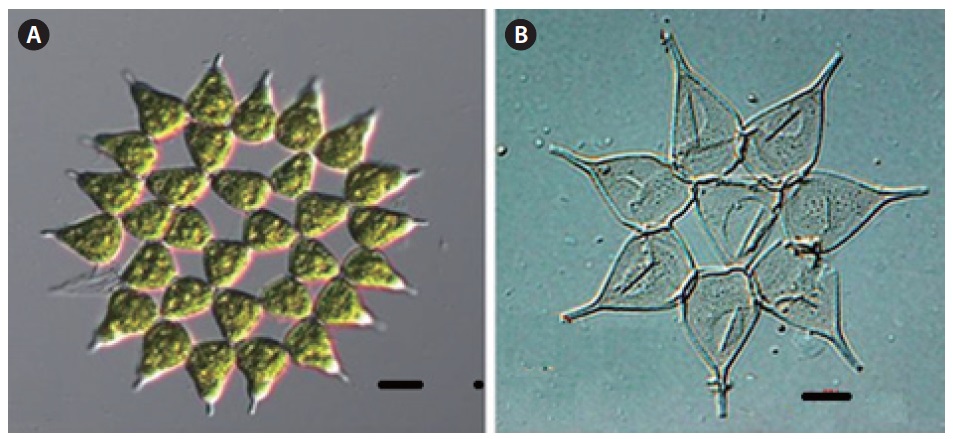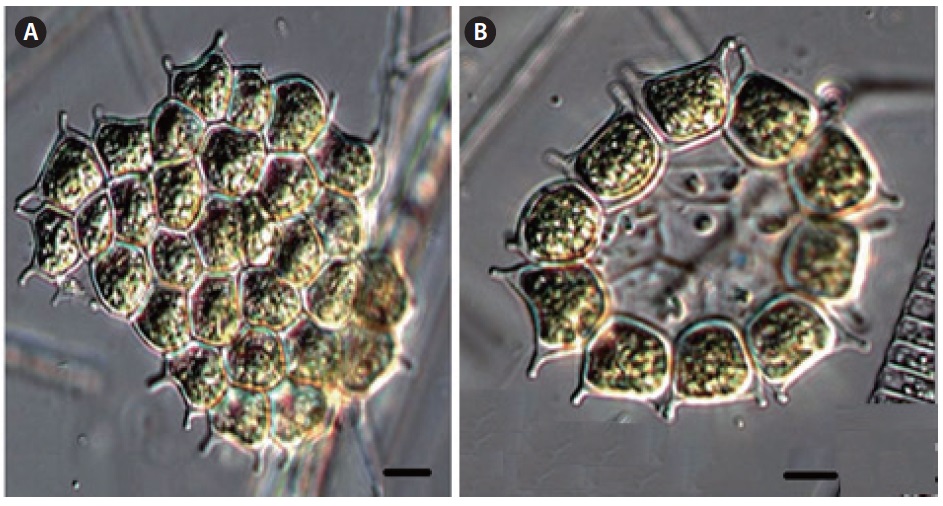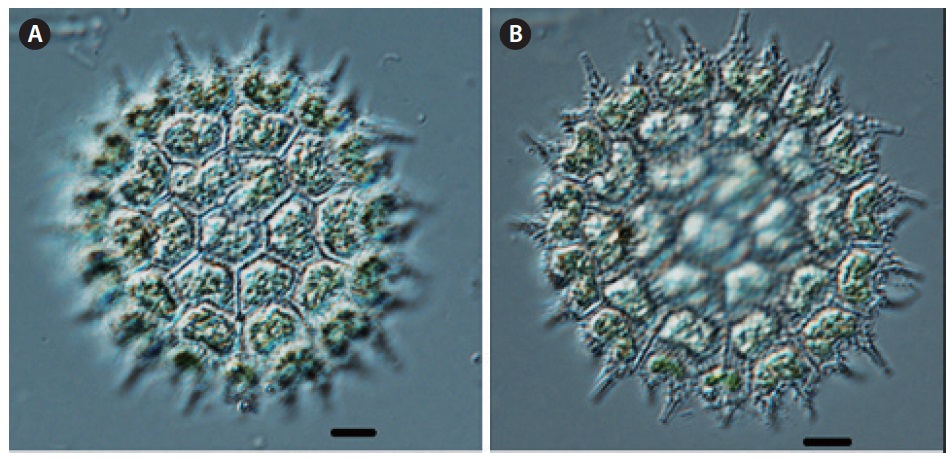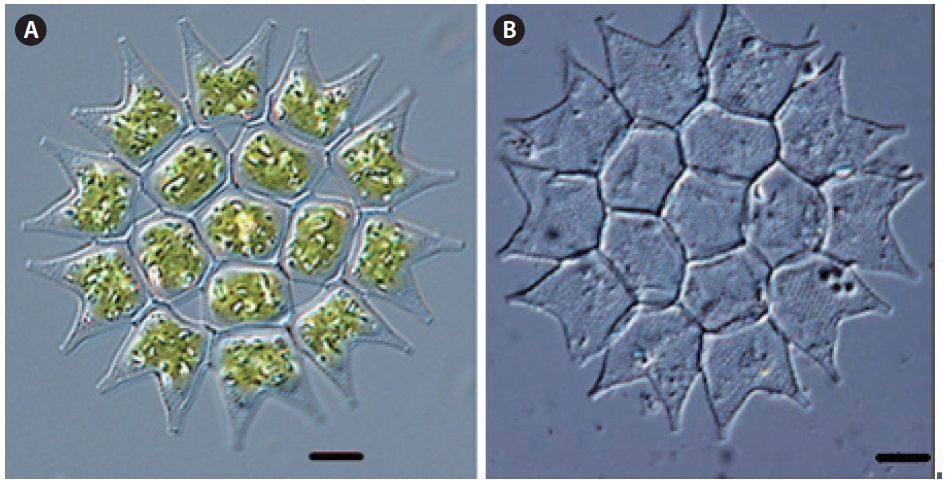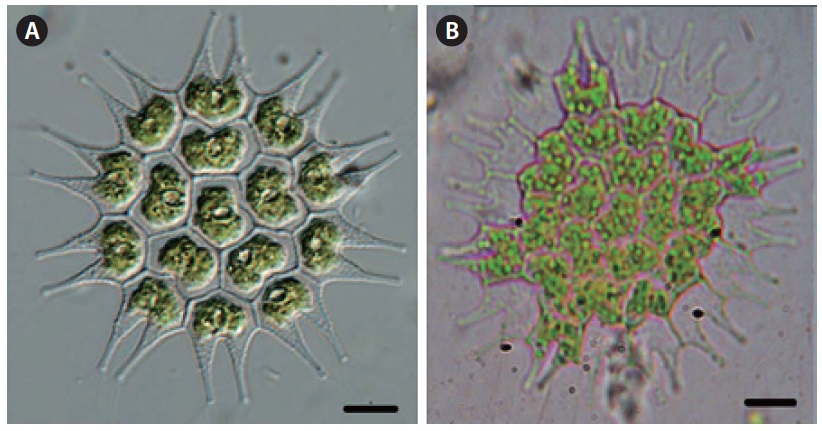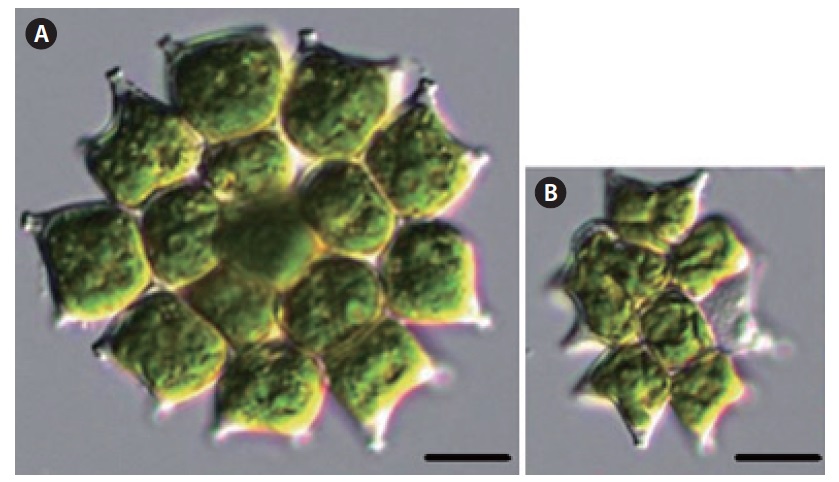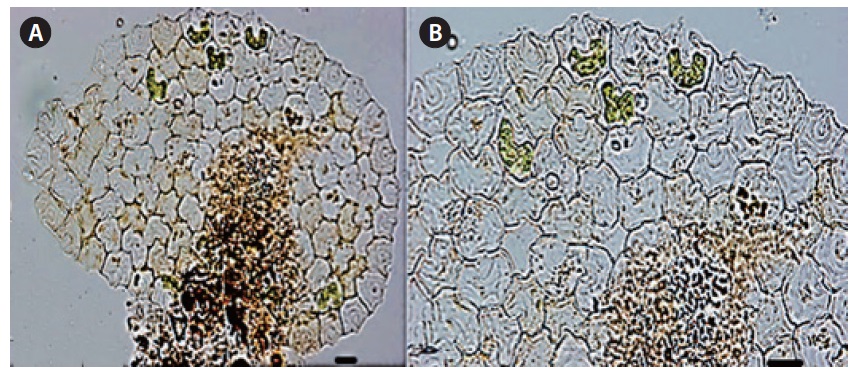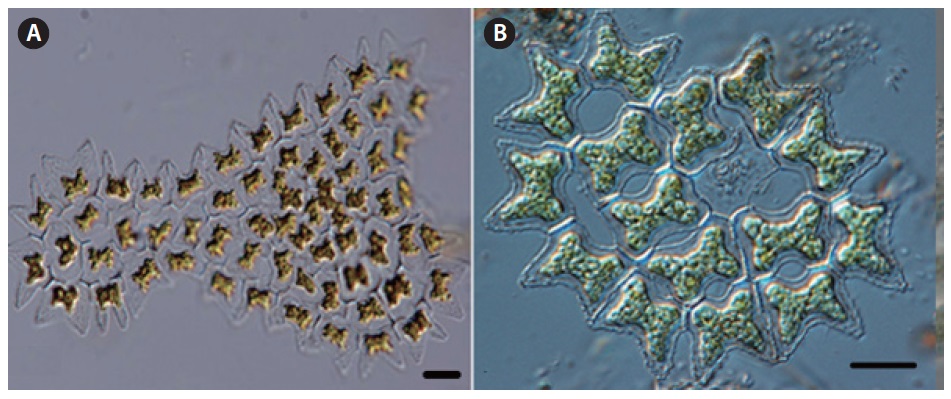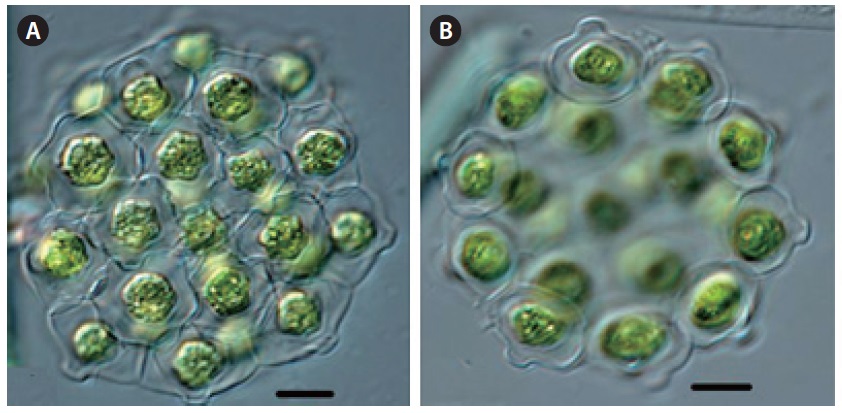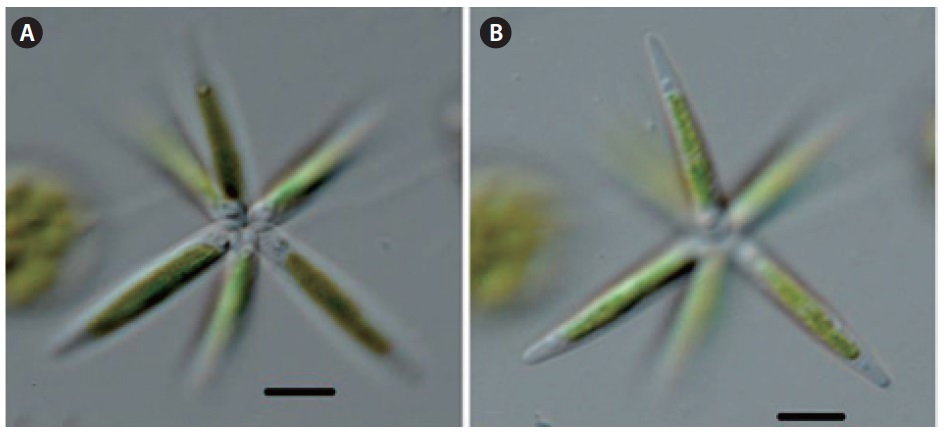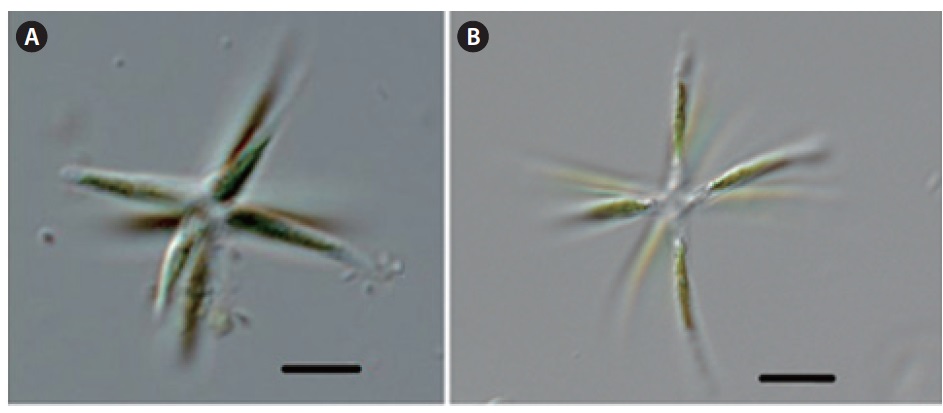



Freshwater green algae (Chlorophyta) are characterized as the largest and most varied algal phylum. The freshwater green algae have great diversity in their cellular organization, morphological structure, and reproductive processes than that of any other algae (Bold et al. 1978). They are closely related to the higher plants in phylogenetic, which have similar structures in their chloroplasts, and photosynthetic pigments (chlorophyll-a, b and carotenoids) and store of starch (e.g., pyrenoid). Green algae comprise 7 orders (i.e., Volvocales, Tetrasporales, Chlorococcales, Microsporales, Chaetophorales, Oedogoniales and Zygnematales), but one of the orders, Zygnematales is separated into the Class Zygnematophyceae from Chlorophyceae by some researchers (Round 1971, Kenrick and Crane 1997).
The Chlorococcales are a large number of species, which are predominantly aquatic system and have the widest distribution among the Chlorophyceae. Chlorococcal algae are mostly unicellular or may form colonies of a definite shape (Prescott 1962). They occur in the plankton and benthos of mesotrophic or eutrophic waters, and are the most diverse with the highest abundance. From the spring to fall, in particular, their reproduction is extensive such that they impart a green vegetation-like color to the water (Hindak 1977). Thus, they play an important role in the primary and secondary successional processes (John and Tsarenko 2002).
Studies of freshwater algae in Korea were begun by Kawamura (1918). He first reported the genus
The family Hydrodictyaceae includes coccal green algae, which have microscopic, flat, spherical and circular coenobium. However, the
The reported taxa belonging to the family Hydrodictyaceae and Coelastraceae in Korea represent 6 genera and 49 taxa, which include the genus
The purpose of this study was to newly record some taxa of the families Hydrodictyaceae and Coelastraceae, order Chlorococcales, and class Chlorophyceae representing 5 genera and 46 taxa from the swamps, ponds, reservoirs, lakes and rivers in Korea (Table 1). Herein I presented the detailed taxonomic information, illustrations, classification, references, synonyms, basionyms and distribution in Korea.
The samples of Chlorococcal algae were collected at 33 stations including ponds, swamp, reservoirs, lakes and rivers from May 2009 to April 2013 (Table 1). Sampling stations were located throughout the country. All samples were collected using 10 μm or 20μm mesh-sized plankton nets with vertical and/or horizontal towing, or submerged benthic or soil algae with spoid or brush. Chlorococcal algae samples were immediately fixed with Lugol’s iodine solution (0.5%) for immobilizing the cells to facilitate microscopic examination. To examine the fine structures and cellular shapes, and to identify and classify the Chlorococcal species, a temporary slide was made using the follow steps: 1) the phytoplankton samples (Chloroccocal algae) were mixed with glycerin in micro tubes. 2) The mixed samples were placed, drop-wise on slide glass, and were fixed in position with cover slides. Permanent slides were made using the follow steps: 1) the phytoplankton samples (Chloroccocal algae) were mixed with liquid glycerol gelatin for mounting histochemical slides (Sigma-Aldrich, St. Louis, MO, USA). 2) The mixed sample was placed drop-wise on slide glass and was fixed in position with a cover slide. 3) it was cemented the margin of a cover glass with manicure (Thecashop, Seoul, Korea). The temporary and permanent slides were observed at ×200 to ×1,600 magnification using light microscopy (LM) (Axioskop 20 and Axio Imager A2; Carl Zeiss, Oberkochen, Germany) with an attached digital camera (Axiocam HRc; Carl Zeiss) being used to capture images. Asterisk mark (*) indicates taxa which are new to Korea.
At each station, physical and chemical factors of water were recorded during the sampling periods. Water temp. (water temperature) and EC (electric conductivity) was measured in situ using a portable thermometer and EC meter (Orion 5-star; Thermo Scientific, Waltham, MA, USA) and a pH was measured in situ using a pH meter (Ultrabasic-5; Denver Instrument, Bohemia, NY, USA) respectively. This study used the data of total nitrogen (TN) and total phosphate (TP) concentrations at each sampling station from the water information system of the Ministry of Environment (NIER 2013).
Chlorococcal algae identification were mainly based on Komarek and Fott (1983), John and Tsarenko (2002), Hindak (1977), Prescott (1962), Hirose and Yamagishi (1977) and Yamagishi and Akiyama (1984 – 1997).
The families Hydrodictyaceae and Coelastraceae, order Chlorococcales, class Chlorophyceae are composed of 5 genera, 29 species, and 17 varieties in this study based on Komarek and Fott (1983), Parra (1979) and Komarek and Jankovska (2001). 8 taxa of these families were newly recorded in Korea:
This study detailed taxonomic information, illustrations, classification, references, basionyms, synonyms and distribution of newly recorded taxa of these families.
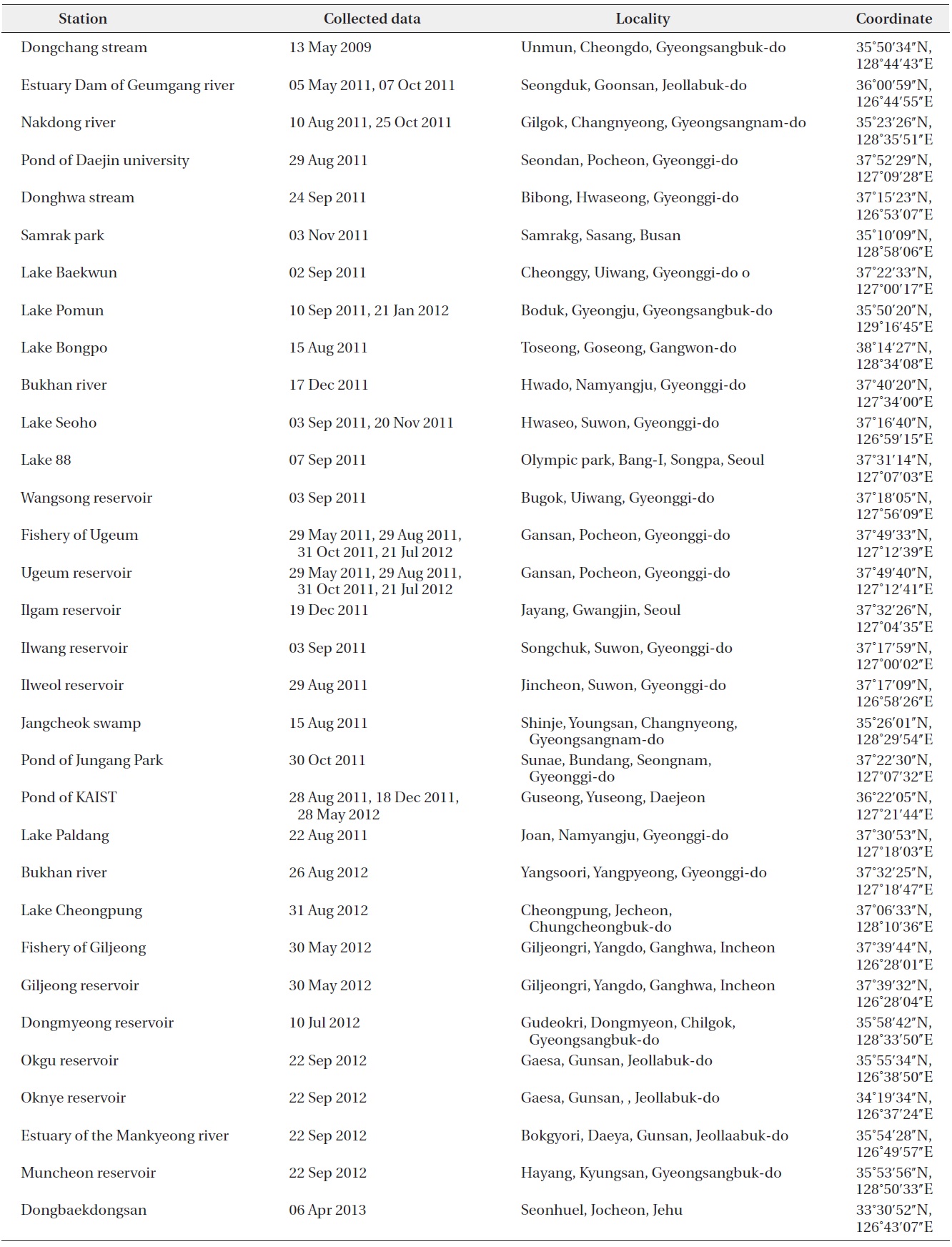
Sampling sites of the families Hydrodictyaceae and Coelastraceae, order Chlorococcales 2009-2013.
Genus Hydrodictyon Roth 1797
Hydrodictyon reticulatum (Linnaeus) Lagerheim 1883
Colonies are macroscopic, with many cylindrical cells adjoined at their ends that formed a pentagonal or hexagonal closed cylindrical net. Cells are 5-15 μm in diameter, 15-70 μm long.
Genus Pediastrum Meyen 1829
Pediastrum simplex Meyen 1829
Colonies are circular to ellipsoid with large intercellular spaces. The marginal cells are Y- to T- shaped with a single horn-like process, the inner cells are Y- shaped. Cells are 6-30μm in diameter, and 12-52 μm long.
Pediastrum simplex var. echinulatum Wittrock 1883 in Wittrock et Nordstedt 1883 (
Synonym:
Illustration: Colonies are mostly composed of 4-8, 16, 32cells. The cells are arranged in a plate, which is either continuous or contains intercellular spaces. The outer cells have one elongated outward pointing process, and an inner polygonal cell. The cell wall surface of each cell is ornamented with teeth-like protuberance. The outer cells are 10-57 μs long, 6-38 μs in diameter, and the inner cells are 6-40 μm long, 6-36 μm in diameter.
Information of sampling sites: This species inhabits in lakes and reservoirs as plankton, and is collected from Wangsong reservoir (03 Sep 2011: water temp. 25.0℃, pH 6.7, EC 227 μs cm-1, TN 2.884 mg L-1, TP 0.094 mg L-1), Lake Geumgang (05 May 2011: water temp. 20.0℃, pH 8.5; EC 227 μs cm-1, TN3.536 mg L-1, TP 0.089 mg L-1), Lake Seoho (03 Sep 2011: water temp. 24.1℃, pH 7.3, EC 569 μs cm-1, TN 6.515mg L-1, TP 0.278 mg L-1), Lake Pomun (10 Sep 2011: water temp. 20.3℃, pH 7.3, EC 82 μs cm-1, TN 0.479mg L-1, TP 0.018 mg L-1).
Key Reference: Wittrock and Nordstedt (1883).
Remark: This taxon has already been reported in Algal flora of Korea by Kim and Kim (2012).
Pediastrum simplex var. biwaense Fukushima 1953
Colonies are circular with large intercellular spaces. The marginal cells are concave with a single process, the inner cells are similar to marginal cell without a process. Cells are 7-20 μm in diameter, and 10-35μm long.
Pediastrum simplex var. sturmii (Reinsch) Wolle 1887 (
Basionym:
Synonym:
Illustration: Colonies are composed of 8-16 cells. The cells are arranged in a ring around a central space with one or more interior cells and a number of peripheral cells, perforation. The central cells are convex, and the cell wall is smooth. Chloroplast is a parietal, with a large pyrenoid. Cells are 8-18 μm in diameter, 14-37 μm long.
Information of sampling sites: This species inhabits in lakes and reservoirs as plankton, and is collected from Wangsong reservoir(03 Sep 2011: water temp. 25.0℃, pH 6.7, EC 227 μs cm-1, TN 2.884 mg L-1, TP 0.094 mg L-1), Lake Gumgang (05 May 2011: water temp. 20.0℃, pH 8.5, EC 227 μs cm-1,TN 3.536 mg L-1, TP 0.089 mg L-1), Lake Seoho(03 Sep 2011: water temp. 24.1℃, pH 7.3, EC 569 μs cm-1, TN 6.515 mg L-1 ,TP 0.278 mg L-1), Lake Pomun (10 Sep 2011: water temp. 20.3℃, pH 7.3, EC 82 μs cm-1, TN 0.479mg L-1, TP 0.018 mg L-1).
Key Reference: Wolle (1887).
Remark: This taxon has already been reported in Algal flora of Korea by Kim and Kim (2012).
*Pediastrum asymmetricum Hegewald et Yamagishi 1994 (
Synonym:
Illustration: Colonies are composed of 8-16 cells, circular in outline, nearly flat, with large perforations. The cells are arranged more or less radially. The marginal cells are elongated, slightly bent, in principle with four lobes, three of the lobes are connected to neighboring cells. The inner cells are rectangular to quadrate with concave sides and four lobes. The cell wall is smooth. Chloroplast is a parietal, with a large pyrenoid. Cells are 8-15 μm in diameter, 10-25 μm long.
Information of sampling sites: This species inhabits in ponds, lakes and reservoirs as plankton, and is collected from from pond at Jungang Park (31 Oct. 2011: no data of water temp., pH and EC), 88 lake in Olympic Park (07 Sep 2012: no data of water temp., pH and EC).
Key Reference: Hegewald and Yamagishi (1994).
Pediastrum integrum Nageli 1849
Colonies are subcircular to ovoid. The outer sides of the
marginal cell have 2 small, truncate processes with a low-triangular base. The inner cells have 5-6 sides, those are nearly straight. The cell wall is granulates. Cells are 15-30 μm in diameter.
Pediastrum obtusum Lucks 1907
Colonies are subcircular to elliptical. The basal part of the marginal cells is quadrate or obtrapezoid, with two major lobes formed by a deep incision at outer side. The outer sides of each lobe are concave and further divided into two short bluntly rounded lobules. The inner cells have 4-5, nearly straight sides, with a deep incision on the outer side. The cell wall smooth, Cells are 10-18 μm in diameter.
Pediastrum tetras (Ehrenberg) Ralfs 1844
Colonies are free-floating, rectangular nearly circular, with 12-74 μm in diameter. The outer sides of the processes are slightly or deeply concave. The inner cells are five to seven angled, with a single deep linear incision and 4-6 straight sides. The marginal cells are 5-18 μm in diameter, and 4-18 μm long. The inner cells are 4-16 μm in diameter, and 4-14 μm long.
Pediastrum privum (Printz) Hegewald 1979 in Hegewald et Schnepf 1979
Colonies are without perforation, with completely joined cell sides. The marginal cells are straight or slightly concave on the outer sides. Cells are 3-6 μm long, and 4-10 μm in diameter.
Pediastrum boryanum (Turpin) Meneghini 1840
Colonies are circular to ellipsoid, without perforations, rarely with small perforations. The marginal cells are 6-35 μm long, and 5-31 μm in diameter. The inner cells are 5-26 μm long, and 4-27 μm in diameter.
Pediastrum boryanum var. brevicorne A. Braun 1855 (
Synonym:
Illustration: Colonies are free-floating, circular to ellipsoid, and consisted of 4 to 32 cells, without perforations. The inner cells are tetragonal. The outer sides of the marginal cells have two short processes. Slight incisions are present between both processes, close to the U-shape in the mature cells. The cell wall is granulates. The marginal cells are 10-20 μm long, and 3-20 μm in diameter. The inner cells are 10-20 μm long, and 6-20 μm in diameter.
Information of sampling sites: This species inhabits in lakes, reservoirs and swamps as plankton or benthos, and is collected from the Nakdong river (25 Oct 2011: water temp. 20.0℃, pH 8.0, TN 2.044 mg L-1, TP 0.073 mg L-1). Swamp in Jangcheok reservoir (15 Aug 2011: water temp. 27.5℃, pH 8.2, TN 0.432 mg L-1, TP 0.038 mg L-1).
Key reference: Braun (1855).
Remark: This taxon has already been reported in Algal flora of Korea by Kim and Kim (2012).
*Pediastrum boryanum var. campanulatum Wille 1924 (
Illustration: Colonies are free-floating, circular to ellipsoid with 16-32-64 cells, without perforations. They are campanulate in shape, not flat. Coenobia are 90-150 μm in diameter. The length of the marginal cells is slightly longer than the width. Neighboring cells are in close contact. Processes of the marginal cells have as long as cells, incision deep, and are V-shaped. The inner cells are slightly incised on the outer side. The cell wall is granulates. The marginal cells are 15-25 μm long, and 12-20 μm in diameter. The inner cells are 7-20 μm long, and 7-20 μm in diameter.
Information of sampling sites: This species inhabits in lake and reservoir as plankton, and collected from 88 lake in Olymphic Park (07 Sep 2012: no data of water temp., pH and EC).
Key reference: Wille (1924).
Pediastrum boryanum var. cornutum (Raciborski) Sulek 1969 (
Basionym:
Synonym:
Illustration: Colonies are free-floating, circular to ellipsoid, and consisted of 16-32-64 cells, without perforations, or sometimes with triangular gaps. Colonies are 120-240 μm in diameter. The length of the marginal cells is slightly longer than the width, the neighboring cells contact 1/3 the length of cell. Processes of the marginal cells have a small spine. Triangular, intercellular spaces are present between the inner cells. Incisions between
both processes are, closed or V-shaped in the mature cells. The cell wall has reticulate sculptures and is granulates. The marginal cells are 15-25 μm long, and 12-20 μm in diameter. The inner cells are 7-20 μm long, and 7-20 μm in diameter.
Information of sampling sites: This species inhabits in lakes, reservoirs and streams as plankton, and is collected from Lake Geumgang (05 May 2011: water temp. 20.0℃, pH 8.5, EC 227 μs cm-1,TN 3.536 mg L-1, TP 0.089 mg L-1), Lake Seoho (03 Sep 2011: water temp. 24.1℃, pH 7.3, EC 569 μs cm-1, TN 6.515mg L-1, TP 0.278 mg L-1), Lake Pomun (10 Sep 2011: water temp. 20.3℃, pH 8.4, EC 82 μs cm-1,TN 0.479 mg L-1, TP 0.016 mg L-1), Pond at KAIST (10 Sep 2011: no data), Donghwa stream (16 Sep 2011: water temp. 22.9℃; pH 7.6; TN 7.277 mg L-1; TP 0.050 mg L-1), Ugeum Reservoir (31 Oct 2011; water temp. 10.7℃, pH 8.7, , EC 95 μs cm-1,TN 1.103 mg L-1, TP 0.055 mg L-1), Ilwang Reservoir (31 Oct 2011: no data).
Key reference: Sulek (1969).
Remark: This taxon is already reported in Algal flora of Korea by Kim and Kim (2012).
Pediastrum boryanum var. longicorne Reinsch 1867
Colonies are circular to ellipsoid. The marginal cells have outer margins that extended into longer processes than are noted in the typical species and the apices of the long processes swollen roundly. The inner cells consisted of 5-6 sides, with or without small intercellular spaces. The marginal cells are 9-40 μm long, and 6-30 μm in diameter. The inner cells are 5-25 μm long, and 6-28 μm in diameter.
Pediastrum boryanum var. forcipatum (Corda) Chodat 1902 (
Basionym:
Synonym:
Illustration: Colonies are free-floating, circular to ellipsoid, and consisted of 8 to 64 cells, sometimes 64-128 cells, without perforations. The outer sides of the marginal cells have two long horn-like processes, which gather a point. Incisions were present between both processes, which are V-shaped and deep. The inner cells slightly incised on the outer side. The cell wall is reticulate with dense granulates. The marginal cells are 13-27 μm long, and 14-23 μm in diameter. The inner cells are 14-22 μm long, and 12-22 μm in diameter.
Information of sampling sites: This species inhabits in ponds, lakes and reservoirs as plankton, and is collected from Lake Geumgang (05 May 2011: water temp. 20.0℃, pH 8.5, EC 227 μs cm-1,TN 3.536 mg L-1, TP 0.089 mg L-1), Lake Seoho (03 Sep2011: water temp. 24.1℃, pH 7.3, EC 569 μs cm-1, TN 6.515mg L-1, TP 0.278 mg L-1), Lake Pomun (10 Sep 2011: water temp. 20.3℃, pH 8.4, EC 82 μs cm-1,TN 0.479 mg L-1, TP 0.016 mg L-1), Pond at KAIST (10 Sep 2011: no data).
Key reference: Chodat (1902).
Remark: This taxon has already been reported in Algal flora of Korea by Kim and Kim (2012).
Pediastrum boryanum var. pseudoglabrum Parra 1979 (
Illustration: Colonies are free-floating, circular to ellipsoid, and consisted of 4-32 cells, with perforations. The outer sides of the marginal cells have two short, horn-like processes. There are slight incisions between both processes, which were wide, shallow, and U-shaped in mature cells. The cell wall has a pore-like structure, and is granulates. The marginal cells are 8-14 μm long, 8-11 μm in diameter. The inner cells are 8-10 μm long, 8-11μm in diameter.
Information of collected sites: This species inhabits in ponds, lakes and reservoirs as plankton, and is collected from Lake Geumgang (05 May 2011: water temp. 20.0℃, pH 8.5, EC 227 μs cm-1,TN 3.536 mg L-1, TP 0.089 mg L-1), Lake Seoho (03 Sep 2011: water temp. 24.1℃, pH 7.3, EC 569 μs cm-1, TN 6.515mg L-1, TP 0.278 mg L-1), Lake Pomun (10 Sep 2011: water temp. 20.3℃, pH 8.4, EC 82 μs cm-1,TN 0.479 mg L-1, TP 0.016 mg L-1), Pond at KAIST (10 Sep 2011: no data).
Key reference: Parra (1979).
Remark: This taxon has already been reported in Algal flora of Korea by Kim and Kim (2012).
Pediastrum boryanum var. perforatum (Raciborski) Nitardy 1914
Colonies are circular to ellipsoid, with perforations. The outer sides of the marginal cells have two short horn-like processes, which tapered gradually. The cell walls are reticulate sculptures, with granulates. The marginal cells are 10-26 μm long, 8-20 μm in diameter. The inner cells are 6-22 μm long, 8-20 μm in diameter.
Pediastrum angulosum (Ehrenberg) Meneghini 1840
Colonies are circular to ellipsoid, without perforations. The outer sides of the marginal cells have two low and horn-like processes. The incised apex of the processes formed a V-shape. The inner cells are tetragon. The cell wall has reticulate ridges. The marginal cells are 10-24 μm long, and 8-22 μm in diameter. The inner cells are 8-18 μm long, and 8-18 μm in diameter.
Pediastrum angulosum var. asperum Sulek in Komarek et Fott 1983 (
Synonym:
Illustration: Colonies are free floating, circular, or ellipsoidal, and consisted of 16, 32, 64 and 128 cells, without
perforation. The basal portion of the marginal cells is polygonal, often quadrate, or pentagonal. Both apices of the outer side are slightly concave, with a V- or U-shaped incision, with two conical processes. The inner cells are polygonal, often pentagonal or hexagonal. The cell wall has irregularly reticulate ridges. Cells are 10-12 μm long, and 10-12 μm in diameter.
Information of sampling sites: This species inhabits in swamp as benthos, and is collected from Dongbaek dongsan, Jeju (05 Apr 2013: water temp. 22.7℃, pH 6.0, EC 83 μs cm-1).
Key reference: Sulek (1969).
Remark: This taxon has already been reported in Algal flora of Korea by Kim and Kim (2012).
Pediastrum argentiniense Bourrelly et Tell in Tell 1979 (
Illustration: Colonies are free floating, circular to ovoid, or slightly irregular, consisted of 16 to 64 or more cells, and have small lenticular perforations between the cells. The basal part of the marginal cells is quadrate or curved quadrate, with two triangular processes formed by a broad V-shaped depression at the outer sides. The lateral sides of neighboring cells are almost joined together, except for a lenticular pore, but sometimes separated by a narrow U- or V-shaped interstice. The inner cells are nearly broad, H-shaped with a perforation between the joining. The cell wall is densely granulates. Cells are 12-20 μm long, and 9-24 μm in diameter.
Information of Collected sites: This species inhabits in lakes and reservoirs as plankton, and collected from Dongbaekdongsan, Jeju (05 Apr 2013: water temp. 22.7℃, pH 6.0, EC 83 μs cm-1).
Key reference: Tell (1979).
Remark: This taxon has already been reported in Algal flora of Korea by Kim and Kim (2012).
Pediastrum biradiatum Meyen 1829
Colonies are subcircular, with large perforations. The marginal cells are curved quadrate, and the inner cells are H-shaped. The cell wall is smooth. The marginal cells are 9-26 μm long, and 8-24 μm in diameter, the inner cells are 8-22 μm long, and 9-24 μm in diameter.
Pediastrum duplex Meyen 1829
Colonies are flat, circular to oval plated, ellipsoidal, and one cell thick. The marginal cells are similar or have two horn-like processes. The inner cells are typically polyhedral with four to many sides. The marginal cells are 7-24 μm long, and 6-22 μm in diameter. The inner cells 5-24 μm long, and 5-27 μm in diameter.
Pediastrum duplex var. gracillimum West et G.S. West 1895
Colonies are flat, circular to oval plated, ellipsoidal. The marginal cells are similar or have two horn-like processes. The inner cells are typically polyhedral with four to many sides. The marginal cells are 7-24 μm long, and 6-22 μm in diameter. The inner cells 5-24 μm long, and 5-27 μm in diameter.
Pediastrum duplex var. rugulosum Raciborski 1890
Colonies are circular to oval plated, ellipsoidal, 15-180 μm in diameter. The marginal cells are similar or have two horn-like processes, which tapered gradually. The marginal and inner cells are deeply concave or slightly incised on the outer sides. The cell walls are smooth, finely reticulate, or highly granulate. The marginal cells are 9-18 μm long, and 10-18 μm in diameter. The inner cells are 8-18 μm long, and 8-18 μm in diameter.
Pediastrum duplex var. asperum (A. Braun) Hansgirg 1886
Colonies are flat, circular to oval plated, ellipsoidal, and one cell thick. The marginal cells are similar or have two horn-like processes, which tapered gradually. The inner side of the marginal cells is concave, the outer side is deeply concave and always wide (V-shaped). The cell wall is irregular. The marginal cells are 8-22 μm long, and 8-19 μm in diameter. The inner cells are 8-18 μm long, and 8-19 μm in diameter.
Pediastrum subgranulatum (Raciborski) Komarek et Jankovska 2001 (
Synonym:
Illustration: Colonies are free floating, flat, circular to oval plated, ellipsoidal, and one cell thick. Colonies typically have 16-64 cells, 100-160 μm in diameter, and have small lens-shaped perforation between the cells, The length of the marginal cells is quadrate, slightly longer than wide, with short two horn-like processes, which tapered gradually. The inner side of the marginal cells is concave. The outer side is deeply concave and always wide (rounded V-shape). The inner cells are quadrate to angular and widely concave in the central margin, and in contact at the central portion of the side wall. The cell wall is fine and densely granulates. The marginal cells are 8-23 μm long, 8-19 μm in diameter. The inner cells 8-14 μm long, 8-23 μm in diameter.
Information of sampling sites: This species inhabits in streams and lakes as plankton, and is collected from the Dongchang stream in Cheongdo-gun (Imdang bridge) (13 May 2009: no data).
Key reference: Komarek and Jankovska (2001).
Remark: This taxon has already been reported in Algal flora of Korea by Kim and Kim (2012).
Genus Sorastrum Kutzing 1845
Sorastrum americanum (Bohlin) Schmidle 1900
Colonies are spherical. The cells are reniform to cuneate, three angled, and radiately arranged at the center to a gelatinous sphere by a short stalk from the basal angle of the cell. Cells are 7-20 μm wide, 10-18 μm long and 4-8 μm thick.
Sorastrum spinulosum Nageli 1849
Colonies are spherical. The cells are rhomboidal, reniform, cuneate, three sided and radiately united at the center to a gelatinous sphere by a short stalk from the basal side. The outer side of cells have two short, 1-4 stout outwardly directed spines. The cells are 8-20 μm wide, 6-18 μm long, and 5-8 μm thick. The spines are 4-5 μm long.
Genus Coelastrum Nageli 1849
Coelastrum microporum Nageli in A. Braun 1855
Colonies are spherical. The cells are also spherical, sometimes ovoid, without any processes on the outer side or interconnecting processes. The cells are 8-20 μm in diameter.
*Coelastrum microporum var. octaedricum (Skuja) Sodomkova 1972 (
Basionym :
Illustration: Colonies are tetrahedral, consisted of 4-8cells. The cells are spherical, sometimes ovoid, and enclosed to adjacent surrounding cells with very small connecting processes. Cells are 8-17 μm in diameter.
Information of sampling sites: This species inhabits in lakes and reservoirs as plankton and on wet soil as benthos, and is collected from fishery of Giljeong (30 May 2012: water temp. 24.0℃, pH 8.8, EC 186 μs cm-1,TN 0.948 mg L-1, TP 0.019 mg L-1), Seorang reservoir (30 May 2012: water temp. 30.4℃, pH 7.0, EC 294.6 μs cm-1), Sayanggol reservoir (29 Apr 2012: water temp. 18.2℃, pH 9.2, EC 162.8 μs cm-1), Spring at Tennis court of Daejin University (26 Sep 2012: no data), Lake Seoho (20 Nov 2012: water temp. 9.4℃, pH 7.6, EC 447 μs cm-1,TN 2.720 mg L-1, TP 0.086 mg L-1), Oknyeo reservoir (22 Sep 2012: water temp. 24℃, pH 9.0, EC 572 μs cm-1,TN 0.855 mg L-1, TP 0.194 mg L-1), Euirim reservoir (31 Aug 2012: water temp. 28.2℃, pH 7.5, EC 138 μs cm-1).
Key reference: Sodomková (1972).
Coelastrum astroideum De-Notaris 1867
Colonies are spherical. The cells are spherical, sometimes ovoid, without obvious interconnecting processes. Cells are 8-20 μm in diameter.
Coelastrum cambricum Archer 1868
Colonies are spherical. The cells are spherical, enclosed by a gelatinous sheath, and have a single process protrude toward the outer free side, which is interconnected and adjoined to cells by the marginal processes. Cells are 6-20 μm in diameter.
Coelastrum sphaericum Nageli 1849
Colonies are spherical or ovoid. The cells are ovoid or conical, connected to other cells by short processes. Cells are 6-25 μm in diameter.
Coelastrum proboscideum Bohlin 1897
Colonies are pyramidal. The cells are conical, truncate or hexagonal, connected to adjacent cells by short, stout processes. Cells are 8-15 μm in diameter.
*Coelastrum morus W. et G.S. West 1896 (
Illustration: Colonies are spherical or ovoid, and consisted of 4, 8, 16 or 32 cells. The cells are spherical, and have truncate wart-like processe toward the outer free side. The cells are interconnected to adjacent cells at the base of cell by short, stout gelatinous processes, Cells are 6-10 μm in diameter.
Information of collected sites: This species inhabits in ponds, lakes and reservoirs as plankton or on west soil as benthos, and is collected from wet soil and spring at Tennis court in Daejin University (26 Sep 2012: no data), Pond at KAIST (11 Sep 2011: no data).
Key reference: West and West (1896).
*Coelastrum pulchrum Schmidle 1892 (
Synonym:
Illustration: Colonies are spherical, consisting 8-16 or 32 cells. The cells spherical, and ovoid, and have a single stout, rounded truncate process projected toward the outside. The cell is connected to an adjacent cell by 4-6 short, stout processes. Intercellular spaces are spherical or triangular, Chloroplast is parietal, with a pyrenoid. Cells are 10-15 μm in diameter.
Information of sampling sites: This species inhabits in lake and reservoir as plankton, and is collected from Lake 88 in Olymphic Park (07 Sep 2012: no data).
Key reference: Schmidle (1893).
*Coelastrum indicum Turner 1892 (
Synonym:
Illustration: Colonies are spherical, and consisted of 8, 16, 32 or 64 cells. The cells are spherical or ovoid, with 5-6 sides in view of the apex. The cell wall of the outer face is slightly thickened. The cells are interconnected to adjacent cells by the processes of the 5-6 lateral at basal part. Intercellular spaces are small, triangular. Chloroplast is parietal, with a pyrenoid, Cells are 5-18 μm in diameter.
Information of sampling sites: This species inhabits in lakes and reservoirs as plankton, and is collected from Imcheon reservoir (09 Jun 2012: water temp. 27.2℃, pH 6.5, EC 129.7 μs cm-1,TN 0.995 mg L-1, TP 0.044 mg L-1), Seorang reservoir (27 May 2012: water temp. 30.4℃, pH 7.0, EC 294.6 μs cm-1), Lake 88 at Olymphic Park (26 Aug 2012: no data), Wangsong reservoir (27 May 2012: water temp. 29.5℃, pH 7.8, EC 435 μs cm-1,TN 3.255 mg L-1, TP 0.136 mg L-1).
Key reference: Turner (1892).
Coelastrum reticulatum (Dangeard) Senn 1899
Colonies are spherical. The cells are also spherical, without wart-like truncate processes, and interconnected to adjacent cells by 1-3 long and slender finger-like
processes. Cells are 6-15 μm in diameter.
Coelastrum polychordum (Korshikov) Hindak 1977
Colonies are spherical. The cells are spherical, have truncate wart-like processes, and are interconnected to adjacent cells by 1-3 long and slender finger-like processes. Cells are 6-15 μm in diameter.
Genus Actinastrum Lagerheim 1882
Actinastrun hantzschii Lagerheim 1882
Cells radiatyely arranged from the center of colonies, cells cylindrical fusiform but truncate at the poles. Cells are 10-26 μm in diameter, and 3-6 μm in diameter.
*Actinastrum hantzschii var. subtile Woloszynska 1911 (
Synonym :
Illustration: Colonies are free floating, and consisted of 4, 8, or 16 cells. The cells are radially arranged from the center of the colony. The cells are cylindrical fusiform, the outer pole is pointed, and the inner pole is truncate, a single chloroplast is parietal, with a single pyrenoid, Cells are 10-30 μm long, and 2-3 μm in diameter.
Information of sampling sites: This species inhabits in lakes, reservoirs and river as plankton, and is collected from Bunhwangri reservoir (10 Nov 2012: water temp. 33.8℃, pH 6.5, EC 229 μs cm-1), the Estuary of Mankyeong river (19 Sep 2012: water temp. 23.5℃, pH 8.5, EC 1880 μs cm-1,TN 2.287 mg L-1, TP 0.127 mg L-1), the Estuary of Dongjin river (19 Sep 2012: water temp. 23.0℃, pH 7.0, EC 806 μs cm-1,TN 2.072 mg L-1, TP 0.048 mg L-1), Lake Seoho (20 Nov 2012: no data), Lake 88 at Olymphic Park (07 Sep 2012: no data).
Key reference: Woloszynska (1911).
Actinastrum fluviatile (Schroder) Fott 1977
Cells are radiately arranged from the center of the colony, cells are cylindrical fusiform. Cells are 10-20 μm long, and 5 μm in diameter.
*Actinastrum aciculare Playfair 1917 (
Illustration: Colonies are free floating, and consisted of 4, 8 or 16 cells. The cells are radially arranged from the center of colony and are composed of coenobium. The cells are curved, slender, long cylindrical fusiform. The outer pole is sharply pointed, and the inner pole is truncate. a single chloroplast is parietal, with a pyrenoid. Cells are 10-30 μm long, and 2-3 μm in diameter.
Information of sampling sites: This species inhabits in lakes, reservoirs and river as plankton, and is collected from the Estuary of Mankyeong river (19 Sep 2012: water temp. 23.5℃, pH 8.5, EC 1880 μs cm-1,TN 2.287 mg L-1, TP 0.127 mg L-1), the Estuary of Dongjin river (19 Sep 2012: water temp. 23.0℃, pH 7.0, EC 806 μs cm-1,TN 2.072 mg L-1, TP 0.048 mg L-1).
Key reference: Playfair (1917).
Actinastrum gracillimum Smith 1916
Cells are radiately arranged from the center of the colony, and rounded truncate at the both poles. Cells are 10-15 μm long, and 2-3 μm in diameter.
Actinastrum gracillimum var. elongatum (Smith) Fott 1977
Cells are radially arranged from the center of the colony and are composed of coenobium. Cells are 30-45 μm long, and 3-5 μm in diameter.
Taxa belonging to these two families (Hydrodictyaceae, Coelastraceae) are distributed cosmopolitan areas (Komarek and Fott 1983, Komarek and Jankovska 2001, Prescott 1962, Yamagishi and Akiyama 1984-1997, Parra 1979). They inhabit standing waters (e.g., swamps, fish ponds, ponds, reservoirs, lakes) and running waters (e.g., rivers, streams) in Korea (1968, Chung et al. 1972, Chung and Lee 1978, Kang 1967, Kim 1994, 1996, Kim and Chang 1997, Kim and Chung 1993, Kim and Lee 1995, Yang et al. 1981).
The surface sculptures of the genus
Several species (i.e.,
The genus
var.
The genus
The families Hydrodictyaceae and Coelastraceae of order Chlorococcales were investigated 5 genera, 29 species, and 17 varieties. Among them, 8 taxa were newly recorded in Korea; 1) Family Hydrodictyaceae:

